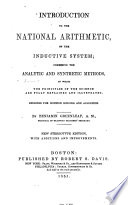 | Benjamin Greenleaf - Arithmetic - 1850 - 368 pages
...the number of common differences, the quotient will be the common difference. Thus 16 -5- 8 = 2 is the common difference. RULE. — Divide the difference of the extremes by the number of terms less one, and the quotient is the common difference. 1. The extremes are 3 and 45, and the number of terms... | |
 | George Roberts Perkins - Arithmetic - 1850 - 356 pages
...the first term, the last term, and the number of terms, to find the common difference, we have this RULE. Divide the difference of the extremes by the number of terms, less one. EXAMPLES. 1 . The first term of an arithmetical progression is 5, the last term is 176, and the... | |
 | John Bonnycastle - 1851 - 314 pages
...of terms, being given, to find the common difference. RULE.1)Divide the difference of the extremos by the number of terms less 1, and the quotient will be the common difference required. * If ii = the first term, l — \ast term, n = number of terms, rf=common difference, and... | |
 | Daniel Leach - Arithmetic - 1851 - 280 pages
...found. 312. To find the common difference when the two extremes and the number of terms are. known,-— RULE. Divide the difference of the extremes by the number of \ terms , less one , and the quotient will be the common difference. This rule may be represented by the formula,... | |
 | Benjamin Greenleaf - 1851 - 332 pages
...quotient will be the common difference. Thus, 27 -fr- 9 = 3, the common difference. Hence the following RULE. — Divide the difference of the extremes by the number of terms less one, and the quotient is the common difference. • EXAMPLES FOR PRACTICE. 1. The extremes of a series... | |
 | Arithmetic - 1851 - 260 pages
...and the last, or fifty-second, payment $1236 ? Ans. 32448. NOTE &. —To find the common difference, divide the difference of the extremes by the number of terms, less one. EXAMPLES. 1 The ages of 8 boys form an arithmetical series-— the youngest is 4 years old and... | |
 | Benjamin Greenleaf - Arithmetic - 1852 - 380 pages
...the number of common differences, the quotient will be the common difference. Thus 16 -T- 8 = 2 is the common difference. RULE. — Divide the difference of the extremes by the number of term* les« one, and the quottent is the common difference. 1. The extremes are 3 and 45, and the number... | |
 | Charles Haynes Haswell - Engineering - 1853 - 318 pages
...far did he travel the last day ? 12—lx5-f-3 = 58 Aris.When the Number of Terms and the Extremes are given., to find the Common Difference. RULE. — Divide the difference of the extremes, by one less than the number of terms. EXAMPLE. — The extremes are 3 and 15, and the number of terms... | |
 | David Henry Cruttenden - Arithmetic - 1853 - 330 pages
...Ans. 6. CASE IV. 1. To find the COMMON DIFFERENCE, knowing the Extremes and the Number of terms. 2. RULE. Divide the difference of the extremes by the number of terms less by 1. 3. Thus, the extremes being 8 and 2258, the number of terms being 76 ; what will be the common... | |
 | Daniel Leach - Arithmetic - 1853 - 622 pages
...found. 312. To find the common difference when the two extvsmes and the number of terms are known, — RULE. Divide the difference of the extremes by the number of terms, less one, and the quotient will be the common difference. This rule may be represented by the formula, thus... | |
| |